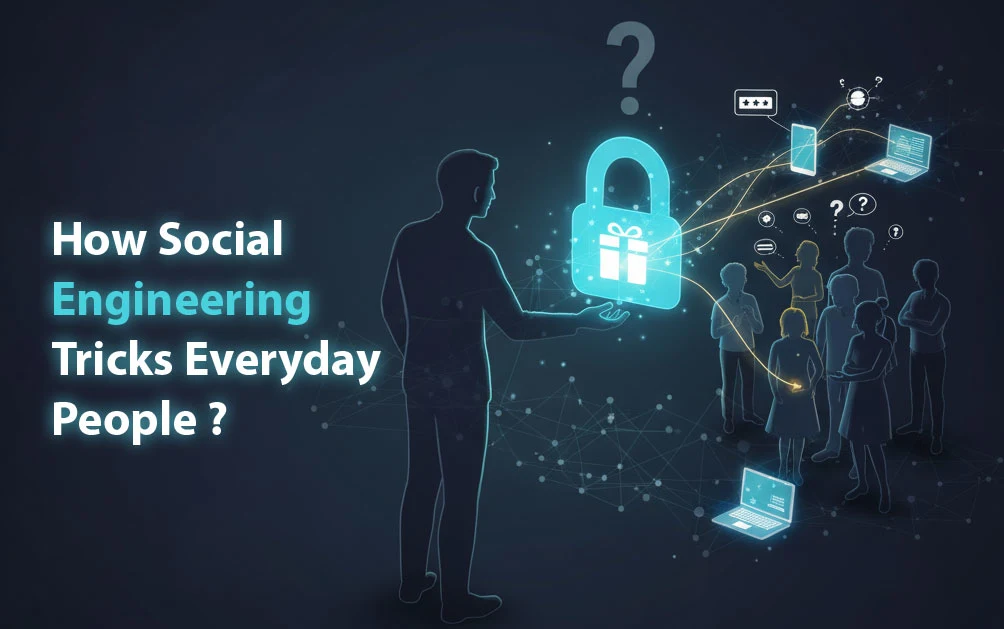How Cyber Criminals Get In?
Ever wondered how cyber criminals sneak into computers and cause chaos? Traditionally, they look for weak spots in the system and use those gaps to get in and do their dirty work. But there’s another trick that really hits home—social engineering.
What’s Social Engineering, Anyway?
So, what’s social engineering? It’s when cyber criminals use human behavior and natural tendencies to get what they want. Instead of hacking the tech, they hack people. Ever seen those pop-ups or emails screaming, “Congratulations, you’ve won an iPhone!”? That’s social engineering in action. The whole idea is to make you click a link, which secretly brings malware into your system.
How Social Engineering Works?
Social engineering is all about manipulating people. Attackers study how folks react to tempting offers or scary situations. They use this knowledge to trick people into making security mistakes or giving up private info. The offers are usually way too good to be true. If it sounds like a dream, it’s probably a trap.
The life cycle of a social engineering attack isn’t simple. First, attackers pick their victims. They do some background research to figure out the best way to mess with someone’s mind. Then, they start chatting up the target, spinning fake stories and slowly gaining control. Once they’ve got the victim hooked, they launch the attack—maybe by getting the person to click a link or share a password. Afterward, the attacker covers their tracks and disappears, leaving the victim clueless.
Types of Social Engineering Attacks
Social engineering attacks can happen anywhere people interact. Here are some of the top tricks:
- Phishing is the most common one. Attackers send emails or texts that create urgency, curiosity, or fear. Maybe you get an email that looks like it’s from your bank, asking you to change your password right away. The link takes you to a fake site that looks just like the real thing. You enter your info, and boom—they’ve got your credentials.
- Spear phishing is like phishing, but more personal. The attacker targets one specific person, usually someone with access to valuable info.
- Baiting is all about tempting offers. Those ads for free software? Sometimes they’re just bait. Click, and you might download a program full of malware or get sent to a shady website.
- Scareware is another sneaky move. You’re suddenly bombarded with pop-ups warning that your computer is infected. To fix it, you’re told to download a program. That program is usually the real threat.
- Pretexting is when the attacker pretends to be someone trustworthy, like a bank official or police officer. They build trust by confirming basic info, then ask for sensitive details like your social security number or bank account.
How to Stay Safe from Social Engineering?
So, how do you stay safe? First, keep your eyes open for fake offers. Don’t open emails or attachments from random sources. If something looks legit, scan it with anti-malware before opening. Never share personal info with strangers online. If someone claims to be an official, double-check their identity.
Be careful with tempting offers. If it sounds too good to be true, it probably is. You can always do a quick search to see if others have reported the same scam. Use multi-factor authentication whenever possible. Even if someone gets your password, they’ll have a harder time breaking in. And always keep your anti-malware software up to date.
Why Social Engineering Works So Well?
Ever gotten a text saying your debit card was used for a fraudulent purchase? The message is urgent, telling you to call a number right away. It feels smart to act fast, but that’s exactly what the scammers want. Social engineering plays on emotions—fear, excitement, curiosity. When you’re emotional, you’re more likely to make a risky choice.
Attackers love urgency. They want you to act before you think. If you get a message from a “trusted” source, double-check everything. Look for weird URLs, low-res images, or typos. Ask yourself: Does this offer sound too good to be true? Would my friend really send this? Can this person prove who they are?
Stay Sharp and Trust Your Gut
Stay cool when you get urgent messages. Don’t rush. Never share sensitive info unless you’re sure who you’re dealing with. Being proactive about your privacy and security is the best way to avoid getting tricked.
Social engineering is surprisingly clear once you know what to look for. Just remember, if something feels off, trust your gut. Stay sharp, and you’ll be one step ahead of the scammers.






